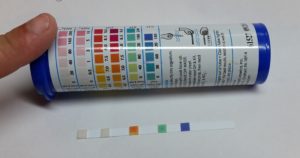Water Part Deux
So after the low mash efficiency last few beers AND my perception (note 1) of low mash efficiency in my last beer, I started looking at water more.
After looking at my options, I found a page on Braukaiser, and ended up purchasing an aquarium test kit that tests GH, KH, pH, NO2, and NO3. The NO2 and NO3 are unnecessary for brewing, and I had 0 ppm for both of those anyway. Using the spreadsheet and my 180ppm measurements for both GH and KH, I found Ca = 51 ppm and Mg = 13 ppm.
That’s not too different from my old measurements:
Ca: old 54, new 51
Mg: old 13, new 13
The two interesting differences are alkalinity and pH.
Alkalinity: old 123, new 180
pH: Old 8.1, new 7.5.
The total alkalinity is a concern – that’s the ability of the water to buffer changes in acidity. And my pH is lower than expected. So I may not have had the wort in the proper pH range. This could be why I’ve had efficiency problems.
That being typed, I need a good pH meter. That’s really the only point that I came to after all this.
Note 1: I initially thought that I had really poor efficiency, and there is a problem somewhere in my measurements… particularly not taking a pre-boil gravity. I have the first running and the second running and the OG, and I determined a potential amount of sugar in the two runnings and it may be okay. The real problem was that I had far too much strike water and didn’t make any adjustments. I DID figure out that if I use Denny Conn’s method, I can safely assume his assumption that 10 pounds of grain absorbs 1 gallon of strike water, because mine is a hair over that.
On to the next beer!
